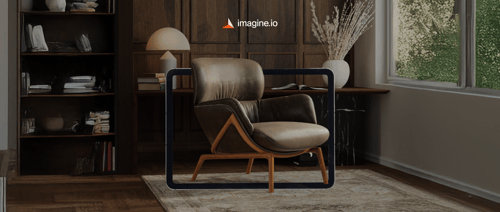If you're in B2B, you already know—your buyers are not just looking for products; they’re seeking precision, customization, and speed. Whether it’s a modular workstation, a complex HVAC setup, or industrial machinery, today’s purchases come with thousands of possible configurations. And in a high-stakes environment, one mistake in the ordering process can mean weeks of delay or thousands lost in rework.
That’s where advanced product configurators step in.
Historically a go-to in B2C for things like customizing sneakers or laptops, configurators are now transforming the B2B landscape. But this isn’t just a tech trend—it’s a strategic shift. In this blog, we’ll explore why B2B businesses are rapidly adopting advanced configurators, what makes them indispensable, and how platforms like imagine.io are quietly changing the game.
Get the latest updates straight to your inbox.
By clicking sign up you'll receive occasional emails from imagine.io. You always have the choice to unsubscribe within every email you receive.
Complexity Demands Customization
B2B product sales are rarely straightforward. You’re not selling a “one-size-fits-all” item—you’re offering a solution that needs to fit a specific use case, environment, or operational need. That’s a whole different level of complexity.
Let’s take the example of a company selling conveyor systems. The buyer might need to specify:
- Motor type and horsepower
- Belt material and width
- Load capacity and speed settings
- Compliance requirements (e.g., FDA, OSHA)
- Additional accessories or guards
Manually handling such variables is risky and inefficient. A configurator simplifies this by guiding buyers through each choice, validating options in real time, and preventing incompatible combinations. The result? Accurate orders, fewer errors, and a faster path to fulfillment.
Bridging Sales and Engineering
Here’s a common bottleneck in B2B sales: A prospect expresses interest. The sales team scrambles to involve engineering. There’s a back-and-forth over specs. Weeks pass before a quote is finalized.
An advanced product configurator eliminates this dance.
Modern configurators—especially those integrated with CRM, ERP, and CPQ systems—can auto-generate everything from sales quotes and pricing to build-ready CAD drawings and BOMs. No manual translation. No miscommunication. Just seamless sales-to-engineering alignment.
Platforms like Configit, BeeGraphy, and yes, imagine.io, offer built-in logic and automation that take this a step further by linking directly to your digital asset library—so every visual, quote, and spec is always accurate and up to date.
Empowering Sales Teams and Distributors

In B2B, your frontline isn’t always your engineering team. It’s your sales reps and distributors.
They’re often tasked with explaining complex products, handling custom requests, and generating quotes—sometimes without deep technical knowledge. That’s a recipe for misalignment unless they’re equipped with the right tools.
Configurators offer guided selling features that walk reps through every step of the configuration process. Think dropdown menus, smart filters, real-time validation, and auto-generated visualizations. This gives your sales teams the power to:
- Respond faster to inquiries
- Reduce dependency on technical teams
- Minimize quote errors
- Close deals quicker
In fact, some companies report up to 40% shorter sales cycles after implementing advanced configurators. That’s not just a tool—that’s a competitive advantage.
Enhancing the B2B Buying Experience

Let’s be honest—B2B buyers are no longer willing to accept clunky PDFs, 2-week quote timelines, or unclear visuals. They expect the same frictionless experience they get as consumers.
A high-quality configurator delivers that. By offering an interactive, self-serve environment, you empower your buyers to:
- Explore options
- Visualize products in real-time
- Receive instant, accurate pricing
- Simulate use-case scenarios (e.g., fit, capacity, compliance)
This isn’t just about convenience—it’s about confidence. Buyers who can clearly see what they’re getting are far more likely to move forward—and come back.
At imagine.io, for example, our 3D product configurators allow users to see every variant of a product—from fabrics and finishes to internal components—in seconds. It's not just beautiful—it’s functional, fast, and deeply aligned with real business needs.
Building for a Digital-First, Scalable Future
The future of B2B commerce is digital—and fast approaching. As Industry 4.0, digital twins, and virtual product experiences continue to evolve, the demand for structured, interactive product data will only intensify.
Configurators don’t just help you sell—they help you scale.
By centralizing product data and offering a repeatable, automated configuration process, businesses can:
- Onboard new products faster
- Train sales and support staff more effectively
- Expand into new markets with fewer localization challenges
- Support ecommerce, in-person, and distributor channels seamlessly
Configurators are also foundational for enabling AI-generated content, AR/VR experiences, and automated digital twins—technologies that are becoming standard in modern product visualization platforms like imagine.io.
Final Thoughts
Advanced product configurators are not optional anymore. They’re strategic assets for any B2B business looking to scale, streamline, and stay relevant.
- They reduce friction in the buying process.
- They eliminate errors in complex configurations.
- They empower your teams—from sales to engineering.
- And most importantly, they deliver the kind of experience today’s B2B buyers expect.
If you’re still managing product configurations through spreadsheets, PDFs, or email threads—it’s time to rethink.
Let’s face it: the competition is already moving ahead. If you’re curious how a configurator can fit into your B2B strategy—or how imagine.io can help you streamline, scale, and succeed—we’d love to show you. Book a Demo and let’s build your digital product experience—together.
.png?width=1440&name=Euro-style%20case-study%20(1).png)

.gif?width=1296&height=1296&name=Untitled%20design%20(8).gif)




.png?width=500&name=How%20to%20Add%20a%203D%20Product%20Configurator%20to%20Your%20WordPress%20Website%20(Complete%20B2B%20Guide).png)
















%20(1).png?width=500&name=Why%20Exploded%20Mattress%20Views%20Matter%20(And%20How%20to%20Generate%20Them)%20(1).png)
.png?width=500&name=Best%20Shopify%20Product%20Configurator_%20How%20to%20Choose%20the%20Right%20One%20(2).png)
.png?width=500&name=Why%20Exploded%20Mattress%20Views%20Matter%20(And%20How%20to%20Generate%20Them).png)



.png?width=500&name=Best%20Shopify%20Product%20Configurator_%20How%20to%20Choose%20the%20Right%20One%20(1).png)







.png?width=500&name=How%203D%20Rendering%20Can%20Make%20or%20Break%20Your%20Industrial%20Design%20Pitch%20(1).png)








%20with%20Digital%20Twins%20and%203D%20Visualization.png?width=500&name=Optimizing%20Your%20Digital%20Asset%20Management%20(DAM)%20with%20Digital%20Twins%20and%203D%20Visualization.png)




.png?width=500&name=Styling%20Home%20Decor%20for%202025_%20From%20Global%20Influences%20to%20Playful%20Personalization%20(1).png)
